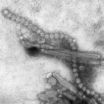In one study, Mark J. Mulligan, M.D., of the Emory University School of Medicine, Atlanta, and colleagues compared the safety and antibody responses (immunogenicity) of different doses of influenza A/Shanghai/2/13 (H7N9) vaccine mixed with or without the MF59 adjuvant (a component that improves immunogenicity and enhances efficacy of inactivated influenza vaccines).
In 2013, human infections with a novel influenza subtype, A/H7N9, were identified in China. Infected patients had live poultry exposures. The virus did not produce disease in poultry; however, it caused severe pneumonia in humans, with hospitalization and mortality rates of 67 percent and 33 percent, respectively. A second wave of infections occurred in winter 2013-2014; through June 27, 2014, a total of 450 laboratory confirmed cases with 165 deaths (36.6 percent) have been reported, according to background information in the study.
This phase 2 trial was conducted at 4 U.S. sites, which enrolled 700 adults ages 19 to 64 years beginning in September 2013; 6-month follow-up was completed in May 2014. The H7N9 inactivated virus vaccine was administered at various doses with or without the MF59 adjuvant among the seven study groups.
Without the MF59 adjuvant, the highest antigen dosage of 45 µg induced minimal antibody responses against H7N9. Higher antigen doses were not associated with increased response. After receiving 2 doses of H7N9 vaccine at a dosage of 3.75 µg plus the MF59 adjuvant, day 42 seroconversion occurred in 58 (59 percent) participants.
Recent receipt of seasonal influenza vaccination and older age were associated with reduced response. No vaccine-related serious adverse events occurred. Postvaccination symptoms were generally mild with more local symptoms seen in participants who received the adjuvant.
"The significant antigen dose-sparing effect of MF59 is an important finding, potentially allowing for protection of many more people with limited vaccine. The study did not determine the optimal antigen dose to combine with MF59 because the lowest dose produced the maximum antibody seroconversion. This is an area for future research," the authors write.
They note that even though these findings indicate potential value in this approach, the study is limited by absence of antibody data beyond 42 days and absence of clinical outcomes. (doi:10.1001/jama.2014.12854; Available pre-embargo to the media at http://media.jamanetwork.com)
Editor's Note: Please see the article for additional information, including other authors, author contributions and affiliations, financial disclosures, funding and support, etc.
In another study, Robert B. Belshe, M.D., of the Saint Louis University School of Medicine, and colleagues examined whether immunologic priming (initial presentation of an antigen to allow antibody responses on revaccination) with vaccine directed toward an older avian influenza H5 strain (A/Vietnam/1203/2004(H5N1) [Vietnam]) might lead to secondary antibody responses to a single dose of a more current H5 avian influenza vaccine (A/Anhui/01/2005 [Anhui]).
Study participants vaccinated 1 year previously (n = 72) with 1 or 2 doses of the Vietnam vaccine received lowdose Anhui vaccine with or without MF59 adjuvant. The researchers also studied the antibody response of 2 doses of Anhui vaccine at 5 different dose levels with or without MF59 in H5N1 vaccinenaive participants (n = 565).
The researchers found that previous receipt of a single dose of Vietnam vaccine was associated with sufficient immunologic priming to increase (boost) response to a different H5N1 antigen using low-dose Anhui vaccine. The secondary antibody responses were brisk (responses seen by day 7) and peaked at 14 days after the boosting vaccination.
This phenomenon was observed with the 2 H5N1 antigens; "participants who are exposed to a related antigen later in life respond with antibody to the initial (priming) antigen as well as to the second (boosting) antigen," the authors write.
In participants who had not previously received H5 vaccine, low dose Anhui vaccine plus adjuvant was more immunogenic compared with higher doses of unadjuvanted vaccine. "In the present study, significant dose sparing was associated with the addition of MF59 adjuvant among vaccinenaive participants; among these participants, the advantage of adding an adjuvant to novel influenza vaccine antigens became apparent." (doi:10.1001/jama.2014.12609; Available pre-embargo to the media at http://media.jamanetwork.com)
Editor's Note: Please see the article for additional information, including other authors, author contributions and affiliations, financial disclosures, funding and support, etc.
Editorial: Expanding the Options for Confronting Pandemic Influenza
In an accompanying editorial, John J. Treanor, M.D., of the University of Rochester, New York, writes that these studies "provide important information that expands the available options for confronting pandemic influenza, and may help surmount those obstacles."
"The current reports by Mulligan et al and Belshe et al, along with other similar studies, have shown that a prepandemic vaccination program is certainly feasible. What would be the components of the decision to implement such a strategy? One important question is the actual risk that an avian virus will emerge to cause a pandemic, and how to determine the risk presented by any new virus. Current research efforts are directed toward determining the molecular markers of virulence and transmission of emerging influenza viruses, and assessing the level of age-related population immunity. If the level of risk appeared to justify a prepandemic vaccination strategy, who should be vaccinated? Creating a priority list of individuals for whom a rapid response to vaccine would be important and might include first responders, health care workers, or possibly higher-risk individuals such as older adults, who appear particularly at risk for severe illness from H7N9 influenza."
INFORMATION:
(doi:10.1001/jama.2014.12558; Available pre-embargo to the media at http://media.jamanetwork.com)
Editor's Note: Please see the article for additional information, including financial disclosures, funding and support, etc.

